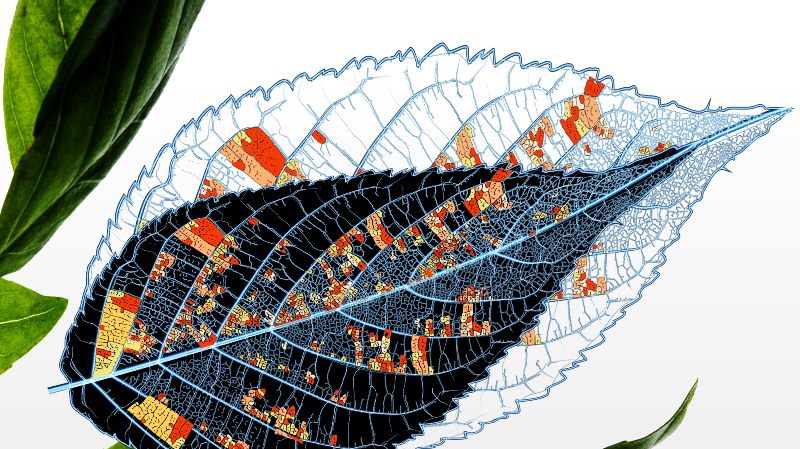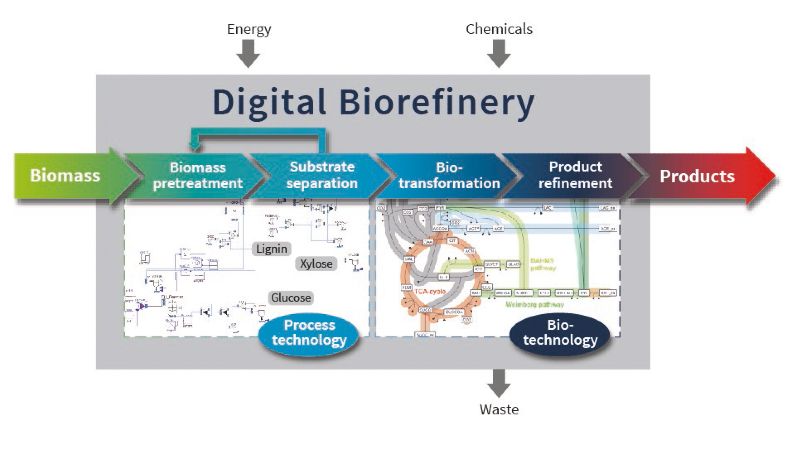
Computer models are playing an increasingly important role in enhancing the competitiveness of bio-based procedures. With their help, it is possible to precisely predict and thus optimize biological and technical processes. This applies in particular to the operation of biorefineries. Their efficiency depends to a large extent on the degree of utilization of the applied renewable resources and their effective conversion into new valuable substances. In the framework of the Be-ProMod Boost Fund project, a digital biorefinery was developed that can map optimal operation strategies in facilities with high modularity and changing input materials.
Renewable resources such as plant or animal biomass are rich in carbohydrates, fats, oils and proteins. Thus, they represent an alternative to crude oil in the production of chemicals. The conversion of biomass into new valuable materials take place in biorefineries and involves a variety of process steps. In order to be competitive compared to crude oil-based procedures, individual steps of the biological and technical processes as well as the overall process need to be optimized. As with crude oil-based refineries, the operation of biorefineries will be economical only if all chemical components are used to the maximum and with the highest efficiency.
Depending on the composition of the biomass and the type of the intermediate and end products desired, there are different biorefinery concepts. On the one hand, research teams are designing biorefineries that can cope with changing input materials, from straw and reeds to wood waste. On the other hand, they are developing optimal operating strategies for facilities that are modular in design and thus can be used flexibly. The highly complex questions involved can no longer be solved purely empirically, that is, by more or less targeted trial and error. It is more effective to digitally model a biorefinery with all its facets and possibilities using a computer model, before it is actually built. The development of such a digital biorefinery was the core task of the “BeProMod” project in the framework of a BioSC Boost Fund. This project was mainly focused on the utilization of lignocellulose-containing biomass. Lignocelluloses provide stability in the cell walls of many plants and even fend off fungi and bacteria with their dense structure. They account for up to 95 percent of the dry biomass in terrestrial plants – thus, they are available in large quantities but are difficult to utilize due to their robustness.

Copyright: IBG-1, Forschungszentrum Jülich
Cracking unruly lignocellulose
At the center of a lignocellulose biorefinery is a biochemical conversion process with microorganisms as the key players. However, these microorganisms initially cannot handle the lignocellulose for its long-chain, highly branched molecular structure and need a technical jump start. The biomass is thus pretreated by mechanical and enzymatic processes. One such process is, for example, the OrganoCat process developed at RWTH Aachen University and the Forschungszentrum Jülich. This process was established on the basis of waste from the wood processing industry and then further developed in the “AP3” FocusLab for the treatment of a wide variety of lignocellulose-containing residue streams (see AP3 article). The substance mixture obtained by the pretreatment is then further separated, resulting in a solids-containing cellulose fraction and an aqueous phase with dissolved sugars and lignin as an additional complex component. While the subsequent enzymatic breakdown of the cellulose into glucose is technically solved, the decomposition of lignin still poses a major challenge and is the subject of current research at the BioSC. Therefore, lignocellulose cannot be entirely utilized - yet. However, two material flows result, containing high yields of sugars with six carbon atoms (glucose) or five carbon atoms (xylose). This small but distinctive difference is vitally important for further microbial bio-transformation.
The sugars released from lignocellulose can be converted by suitable microorganisms and their natural enzymes into desired
intermediate and final products. However, there are two basic biological issues to be considered: First, there is no SINGLE industrially applicable microorganism that naturally utilizes all the different sugars from the pretreatment stages. Second, based on different cell types and metabolic pathways, there are always several pathways that allow the utilization of a particular sugar. The task of the researchers was to find the optimal procedure. Depending on the defined starting material (e.g. C5- or C6 sugar) and the desired target product, the conversion can cause a more or less by-product formation of CO2. This positively or negatively affects the efficiency of the carbon use in the overall process of the biorefinery and thus also the economic efficiency as well as the ecological footprint.
At this point digital comes into play.
Many small models result in the big picture
Computer-aided process modeling and optimization steadily increase the competitiveness of bio-based procedures compared to existing conventional methods. Due to the outlined complexity of a biorefinery, the creation of a digital computer model requires the expertise of scientists from different disciplines – above all bio- and system- process engineering. In the framework of the BeProMod BioSC project, scientists of the RWTH Aachen University and the Forschungszentrum Jülich created a first demonstration model of a digital biorefinery.
The level of detail ranges from the biological description of individual enzyme-kinetics reactions to complex microbial metabolic networks and from the technical implementation of various basic operations and reactor types to complete process chains of a biorefinery. The model approach was chosen in a way that future further extensions based on new experimental data and in-depth knowledge is easily possible. Special attention was paid to user-friendliness and reusability of individual model components to allow modelling of dynamic processes from other scopes of application. In a first concrete case study, a production process was modelled in which microorganisms provide the organic acid succinate as an important precursor for industrial plastics production. The key player in this process was the model organism Corynebacterium glutamicum, which was optimized for this task.
With the help of the computer model, ideal strain and process variants could be identified for a scalable production of succinate based on OrganoCat substrates. The jump from the digital world into a real-world biorefinery is being prepared in the “HyImPAct” BioSC FocusLab, among others. The experimental implementation and further techno-economic questions concerning the best possible production process are assessed here.
Project Coordinator
Dr.-Ing. Stephan Noack
IBG-1 Biotechnology, Forschungszentrum Jülich
Email
Participating Core Groups
Prof. Dr.-Ing. Wolfgang Wiechert, Dr.-Ing. Stephan Noack, Dr.-Ing. Eric von Lieres, Dr.-Ing. Xiao Zhao
IBG-1 Biotechnology, Forschungszentrum Jülich
Prof. Dr.-Ing. Alexander Mitsos, Dr. Ralf Hannemann-Tamás, Tobias Ploch
AVT – Process Systems Engineering, RWTH Aachen
Prof. Dr. Uwe Naumann, Jonathan Hüser
Software und Tools für Computational Engineering, RWTH Aachen
Funding Period
01.07.2014 – 30.06.2017
Funding
BeProMod is part of the NRW-Strategieprojekt BioSC and thus funded by the Ministry of Culture and Science of the German State of North Rhine-Westphalia.
Publikationen
Lotz, J, Naumann, U, Hannemann-Taḿas, R, Ploch, T and Mitsos, A (2015). Higher-order discrete adjoint ode solver in c++ for dynamic optimization. Procedia Computer Science 51: 256-265.
Lotz, J, Schwalbach, M and Naumann, U (2016). A case study in adjoint sensitivity analysis of parameter calibration. Procedia Computer Science 80: 201-211.
Safiran, N, Lotz, J and Naumann, U (2016). Algorithmic differentiation of numerical methods: Second-order adjoint solvers for parameterized systems of nonlinear equations. Procedia Computer Science 80: 2231-2235.
Zhao, X, Noack, S, Wiechert, W and Lieres, EV (2017). Dynamic flux balance analysis with nonlinear objective function. J Math Biol